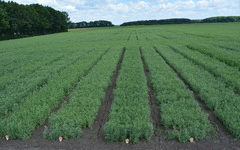Features of the formation of protein content and wet gluten content of winter bread wheat depending on the preceding crop
DOI:
https://doi.org/10.21498/2518-1017.21.3.2025.339319Keywords:
Triticum aestivum L., varieties, breeding lines, year conditions, coefficient of variation, ANOVAAbstract
Purpose. To identify the features of the formation of protein content and wet gluten content of winter bread wheat varieties and breeding lines depending on different preceding crops in the conditions of the central part of the Forest-Steppe of Ukraine. To identify genotypes with increased grain quality indicators. Methods. The influence of five preceding crops (soybean, sunflower, corn, mustard, green manure (mustard)) on the formation of protein content (PC) and wet gluten content (WGC) in flour of 18 winter bread wheat genotypes was studied from 2021/22 to 2023/24. Field, laboratory and statistical research methods were employed. Results. On average, a significantly higher protein content (12.5%) and gluten content (27.6%) were found after green manure over the years. However, a higher protein content was observed after soybeans of the ‘MIP Dovira’ variety (13.1%) and after corn of the Lutescens 37548 (13.6%), Lutescens 60302 (12.7%) and Lutescens 60400 (12.8%) breeding lines. A significantly higher wet gluten content was obtained after corn in the Lutescens 37548 breeding line (29.8%) and after mustard in the Lutescens 60302 breeding line (29.1%). The lowest values of these indicators were recorded over three years (PC = 9.7–12.3%, WGC = 13.0–25.8%) following a sunflower crop. However, the breeding lines Lutescens 37548 and Lutescens 60302 showed lower quality indicators following a preceding crop of soybean. Moderate variability (6 ≤ CV ≤ 10%) in protein content and significant variability (11 ≤ CV ≤ 20%) in gluten content were observed for most winter bread wheat varieties and breeding lines depending on the preceding crop. The influence of growing year conditions on protein (48.3%) and wet gluten (41.2%) content was significant, with the respective shares of the preceding crop and genotype being 9.9% and 17.2%, and 4.8% and 5.4%, respectively. A strong, reliable linear relationship (r = 0.83) was identified between protein and wet gluten content in winter bread wheat varieties and breeding lines. Breeding lines of winter bread wheat with a higher protein content were identified: Erythrospermum 60724, Erythrospermum 60793, Erythrospermum 60667, Lutescens 60293, Lutescens 60734 and Lutescens 37548. Breeding lines with a higher wet gluten content were also identified: Lutescens 60302. Conclusions. The selected genotypes can be used in the breeding process to improve individual grain quality indicators. To obtain a higher protein and gluten content, the variety ‘MIP Dovira’ should be sown after the preceding crop soybean, the breeding lines Lutescens 37548, Lutescens 60302, Lutescens 60400 should be sown after corn, and other winter wheat genotypes should be sown after green manure.
Downloads
References
Velimirović, A., Jovović, Z., & Pržulj, N. (2021). From neolithic to late modern period: Brief history of wheat. Genetika, 53(1), 407–417. https://doi.org/10.2298/gensr2101407v

FAOSTAT. 2019–2023. https://www.fao.org/faostat/en/#data/OA
Prokopenko, O. (Ed). (2022). Crop Production of Ukraine 2022. Statistical Collection. Derzhavna Sluzhba Statystyky Ukrainy. [In Ukrainian]
Khalid, A., Hameed, A., & Tahir, M. F. (2023). Wheat quality: A review on chemical composition, nutritional attributes, grain anatomy, types, classification, and function of seed storage proteins in bread making quality. Frontiers in Nutrition, 10, Article 1053196. https://doi.org/10.3389/fnut.2023.1053196
 |
| 
Adam, D. (2021). How far will global population rise? Researchers can’t agree. Nature, 597(7877), 462–465. https://doi.org/10.1038/d41586-021-02522-6
 |
| 
Islam, M. Z., Alam, M. N., Rahman, M. M., Islam, M. Z., & Rahman, A. (2024). Nutritional values of wheat and the roles and functions of its compositions in health. Preprints. https://doi.org/10.20944/preprints202409.0710.v1
Szuba-Trznadel, A., Gałka, B., Kamińska, J., Rodzeńska, A. J., Król, Z., Jarki, D., & Fuchs, B. (2024). Diversity of chemical composition and nutritional value in grain from selected winter wheat cultivars grown in south-western Poland. Scientific Reports, 14(1), Article 2630. https://doi.org/10.1038/s41598-024-53094-0
 |
| 
Wieser, H., Koehler, P., & Scherf, K. A. (2023). Chemistry of wheat gluten proteins: Quantitative composition. Cereal Chemistry, 100(1), 36–55. https://doi.org/10.1002/cche.10553

Rustgi, S., Shewry, P., Brouns, F., Deleu, L. J., & Delcour, J. A. (2019). Wheat seed proteins: factors influencing their content, composition, and technological properties, and strategies to reduce adverse reactions. Comprehensive Reviews in Food Science and Food Safety, 18(6), 1751–1769. https://doi.org/10.1111/1541-4337.12493
 |
| 
Penaki, A., & Borta, A. (2020). The study of quality indicators and fractional composition of wheat grain protein of southern regions of Ukraine. Grain Products and Mixed Fodder’s, 20(4), 4–10. https://doi.org/10.15673/gpmf.v4i4.2013
Ye, L., Zheng, W., Li, X., Han, W., Shen, J., Lin, Q., Hou, L., Liao, L., & Zeng, X. (2023). The role of gluten in food products and dietary restriction: exploring the potential for restoring immune tolerance. Foods, 12(22), Article 4179. https://doi.org/10.3390/foods12224179
 |
| 
Bodor, K., Szilágyi, J., Salamon, B., Szakács, O., & Bodor, Z. (2024). Physical–chemical analysis of different types of flours available in the Romanian market. Scientific Reports, 14(1), Article 881. https://doi.org/10.1038/s41598-023-49535-x
 |
| 
Wieser, H., Koehler, P., & Scherf, K. A. (2023). Chemistry of wheat gluten proteins: Qualitative composition. Cereal Chemistry, 100(1), 23–35. https://doi.org/10.1002/cche.10572

Filip, E., Woronko, K., Stępień, E., & Czarniecka, N. (2023). An overview of factors affecting the functional quality of common wheat (Triticum aestivum L.). International Journal of Molecular Sciences, 24(8), Article 7524. https://doi.org/10.3390/ijms24087524
 |
| 
Vozhegova, R. A., Netis, I. T., Onufran, L. I., Sakhatsky, G. I., & Sharata, N. H. (2021). Climate change and aridization of the Southern Steppe of Ukraine. Agrarian Innovations, 7, 16–20. https://doi.org/10.32848/agrar.innov.2021.7.3 [In Ukrainian]
Gabric, A. J. (2023). The climate change crisis: a review of its causes and possible responses. Atmosphere, 14(7), Article 1081. https://doi.org/10.3390/atmos14071081

Xie, W., & Yan, X. (2023). Responses of wheat protein content and protein yield to future climate change in China during 2041–2060. Sustainability, 15(19), Article 14204. https://doi.org/10.3390/su151914204

Aono, S., Nishitsuji, Ya., Iwaki, S., & Hayakawa, K. (2024). Effects of environmental temperature during maturation on protein characteristics in spring wheat (Triticum aestivum cv. Haruyokoi). Journal of Cereal Science, 116, Article 103838. https://doi.org/10.1016/j.jcs.2023.103838

Kollstrøm, M. O., Böcker, U., Uhlen, A. K., Kristoffersen, A. Ø., Dieseth, J. A., Tengstrand, E., & Koga, S. (2025). The effect of weather conditions from heading to harvest on gluten quality of spring wheat – A study of historical data 2005–2022. Journal of Cereal Science, 121, Article 104095. https://doi.org/10.1016/j.jcs.2024.104095

Mitura, K., Cacak-Pietrzak, G., Feledyn-Szewczyk, B., Szablewski, T., & Studnicki, M. (2023). Yield and grain quality of common wheat (Triticum aestivum L.) depending on the different farming systems (organic vs. integrated vs. conventional). Plants, 12(5), Article 1022. https://doi.org/10.3390/plants12051022
 |
| 
Long, X.-X., Ju, H., Wang, J.-D., Gong, Sh.-H., & Li, G.-Yo. (2022). Impact of climate change on wheat yield and quality in the Yellow River Basin under RCP8.5 during 2020–2050. Advances in Climate Change Research, 13(3), 397–407. https://doi.org/10.1016/j.accre.2022.02.006

Demydov, O. A, Pravdziva, I. V., & Vasylenko, N. V. (2023). The influence of growing season conditions, sowing date, and preceding crop on the flour strength formation in Triticum aestivum L. genotypes. Foothill and Mountain Agriculture and Stockbreeding, 74(2), 27–38. https://doi.org/10.32636/01308521.2023-(74)-2-3 [In Ukrainian]
Yashchuk, N., Matseiko, L., Bober, A., Kobernyk, M., Gunko, S., Grevtseva, N., Boyko, Y., Salavor, O., Bublienko, N., & Babych, I. (2021). The technological properties of winter wheat grain during long-term storage. Potravinarstvo Slovak Journal of Food Sciences, 15, 926–938. https://doi.org/10.5219/1642

Tsymbal, Ya. S., Boiko, P. I., Martyniuk, I. V., Yakymenko, L. P., & Bakumova, M. V. (2024) Productivity of winter wheat in 6-7-field crop rotations of the Left Bank Forest-Steppe. Agriculture and Plant Sciences: Theory and Practice, 4, 25–32. https://doi.org/10.54651/agri.2024.04.03 [In Ukrainian]
Siroshtan, A. A., & Kavunets, V. P. (Eds.). (2023). Technology of Growing Winter Wheat Seeds. Tsentralne. [In Ukrainian]
Wheat. Technical conditions: State Standard of Ukraine 3768:2019. (2019). DP “UkrNDNTs”. [in Ukrainian]
Technological assessment of crop production of varieties of agricultural species. (2016). In S. O. Tkachyk (Ed.), Methodology for conducting qualification examination of plant varieties for suitability for distribution in Ukraine. Methods for determining quality indicators of crop production (4th ed., pp. 6–64). Nilan-LTD. [In Ukrainian]
Gamaiunova, V. V., & Smirnova, I. V. (2017). Methods and organization of research in agronomy. Mykolaiv National Agrarian University. https://dspace.mnau.edu.ua/jspui/bitstream/123456789/2075/1/Metody_ta_orhanizatsiya_doslidzhen_v_ahronomiyi.pdf [In Ukrainian]
Chugaevska, S. V., & Kovtun, N. V. (Eds.). (2022). Fundamentals of statistical modeling: a textbook. Ruta. https://eprints.zu.edu.ua/33864/1/stat.pdf [In Ukrainian]
Jones, C., & Olson-Rutz, K. (2025). Practices to increase wheat grain protein. Montana State University. https://landresources.montana.edu/soilfertility/documents/PDF/pub/NWhtProtEB0206.pdf
Kolibabchuk, T. V., Kuzmenko, O. V., Zarva, O. I., & Liubych, V. V. (2022). Yield and quality of soft winter wheat depending on the sowing rates. Agrobiology, 1, 168–178. https://doi.org/10.33245/2310-9270-2022-171-1-168-178 [In Ukrainian]
Blyzniuk, B. V., Demydov, O. A., Kyrylenko, V. V., Humeniuk, O. V., & Pykalo, S. V. (2020). Influence of environmental factors on formation of grain quality of winter wheat (Triticum aestivum L.) varieties of Myronivka breeding. Agroecological Journal, 3, 63–72. https://doi.org/10.33730/2077-4893.3.2020.211528 [In Ukrainian]
Downloads
Published
How to Cite
Issue
Section
License
Copyright (c) 2025 І. В. Правдзіва, Н. В. Василенко, Т. М. Шадчина, Т. В. Шевченко

This work is licensed under a Creative Commons Attribution-ShareAlike 4.0 International License.
Starting in 2022, the copyright to the publication remains with the authors
Our journal abides by the CREATIVE COMMONS copyright rights and permissions for open access journals.
Authors, who are published in this journal, agree to the following conditions:
- The authors reserve the right to authorship of the work and pass the first publication right of this work to the journal under the terms of a Creative Commons Attribution License, which allows others to freely distribute the published research with the obligatory reference to the authors of the original work and the first publication of the work in this journal.
- The authors have the right to conclude separate supplement agreements that relate to non-exclusive work distribution in the form in which it has been published by the journal (for example, to upload the work to the online storage of the journal or publish it as part of a monograph), provided that the reference to the first publication of the work in this journal is included.
























 Ukrainian Institute for Plant Varieties Examination
Ukrainian Institute for Plant Varieties Examination  Селекційно-генетичний інститут
Селекційно-генетичний інститут Institute of Plant Physiology and Genetics of the National Academy of Sciences of Ukraine
Institute of Plant Physiology and Genetics of the National Academy of Sciences of Ukraine
 The National Academy of Agrarian Sciences of Ukraine
The National Academy of Agrarian Sciences of Ukraine